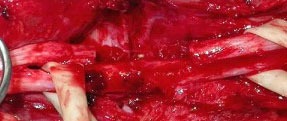

Nerve grafts are used when a patient has a nerve injury resulting in complete loss of muscle function or sensation.
A nerve graft is a surgical technique in which a segment of unrelated nerve is used to replace or bridge an injured portion of nerve. The donor nerve serves as a “track” along which axons can grow down to the target area.
Clinical Treatments:
Surgery can be done in case a peripheral nerve has become cut or otherwise divided. This is called peripheral nerve reconstruction or Nerve Grafting. The injured nerve is identified and exposed so that normal nerve tissue can be examined above and below the level of injury, usually with magnification, using either loupes or an operating microscope. If a large segment of nerve is harmed, as can happen in a crush or stretch injury, the nerve will need to be exposed over a larger area. Injured portions of the nerve are removed. The cut nerve endings are then carefully reapproximated using very small sutures. The nerve repair must be covered by healthy tissue, which can be as simple as closing the skin or it can require moving skin or muscle to provide healthy padded coverage over the nerve. The type of anesthesia used depends on the complexity of the injury. A surgical tourniquet is almost always used.



